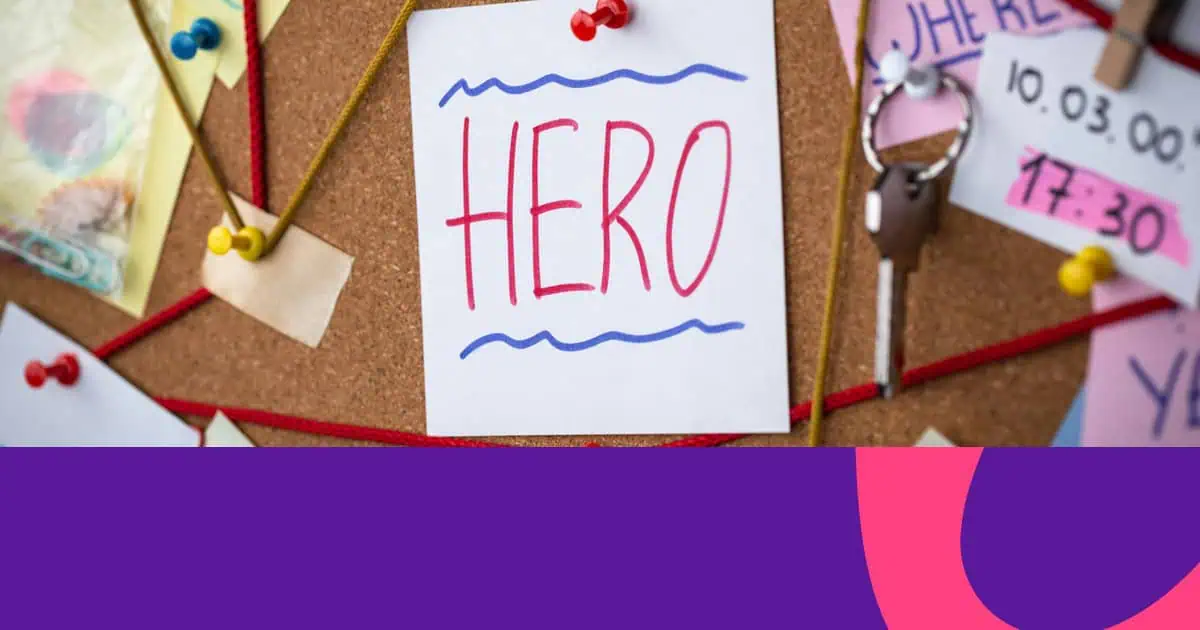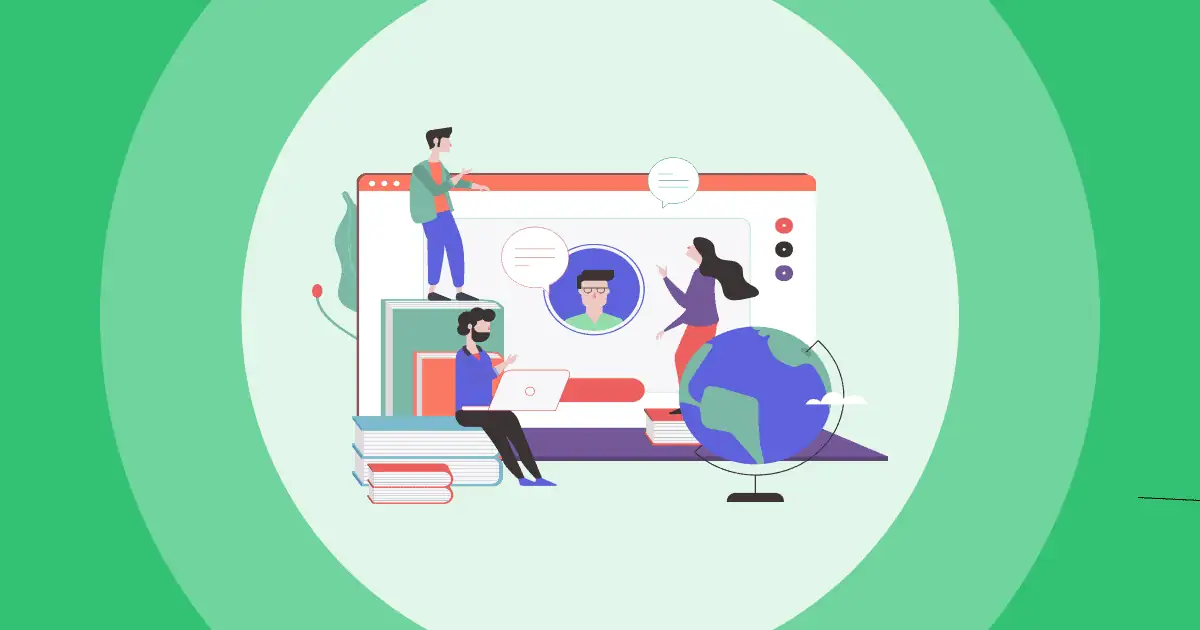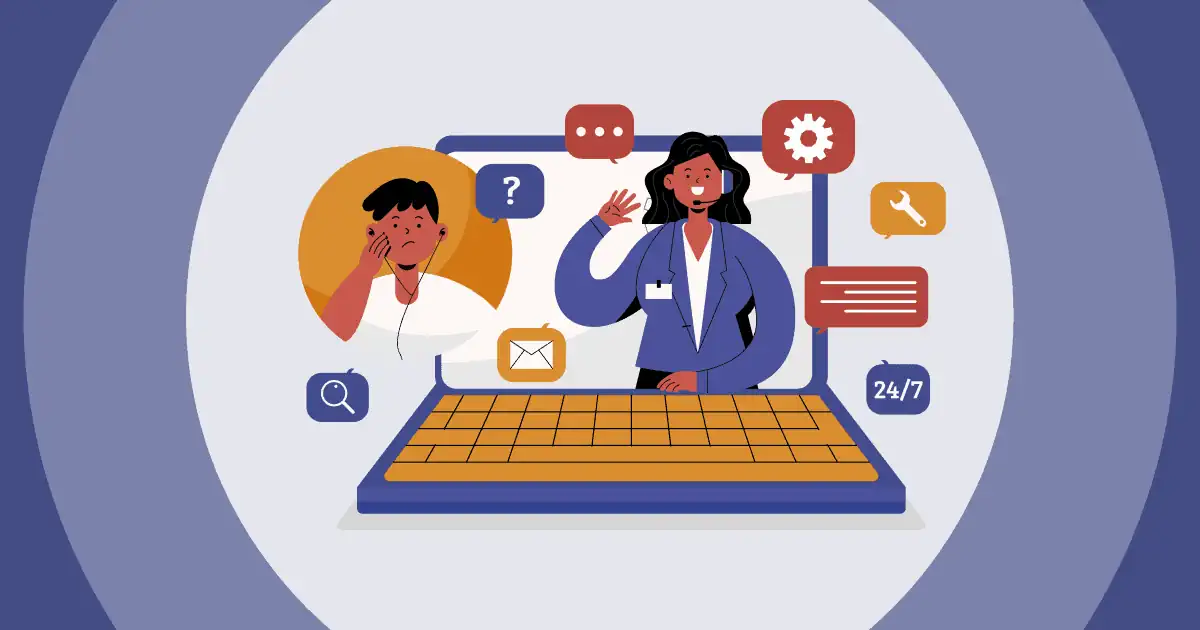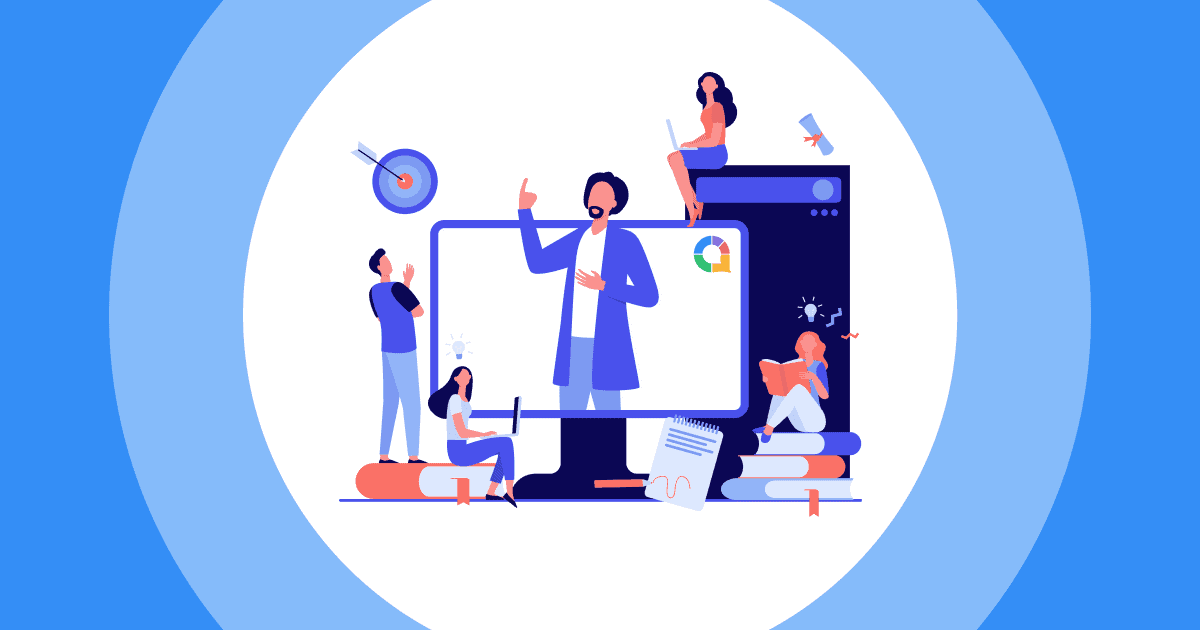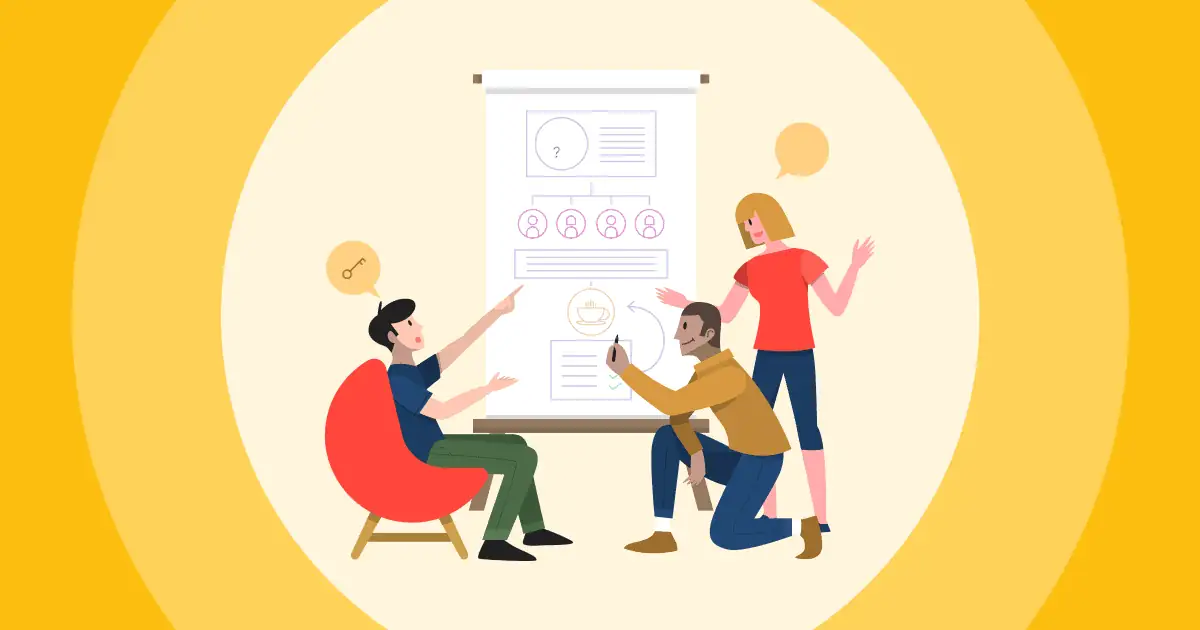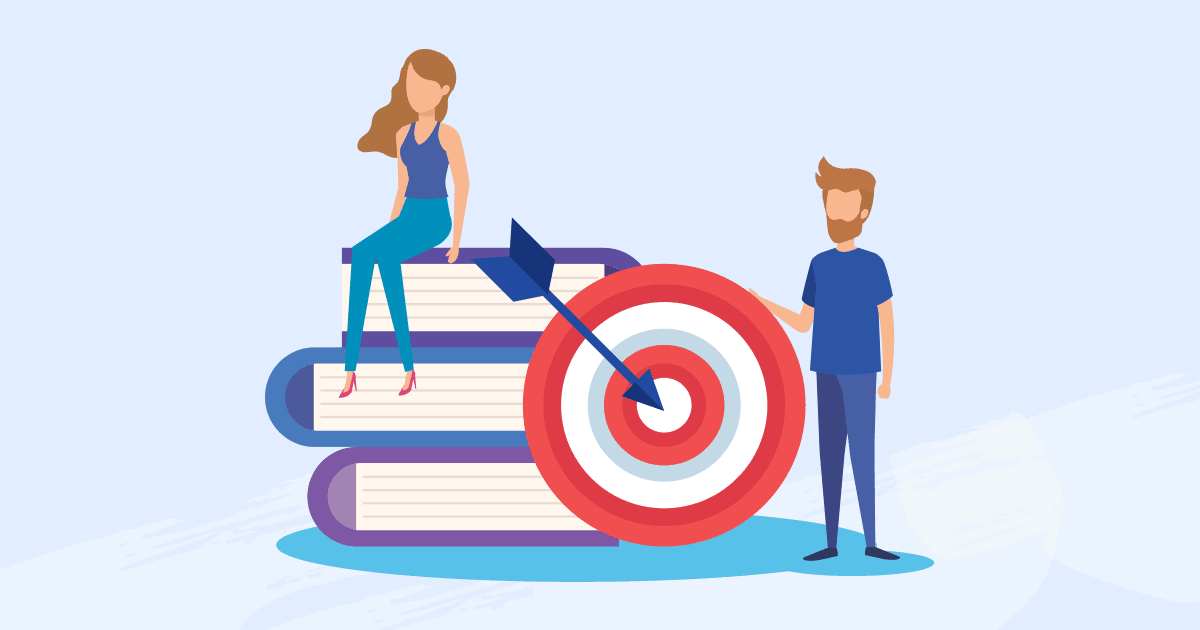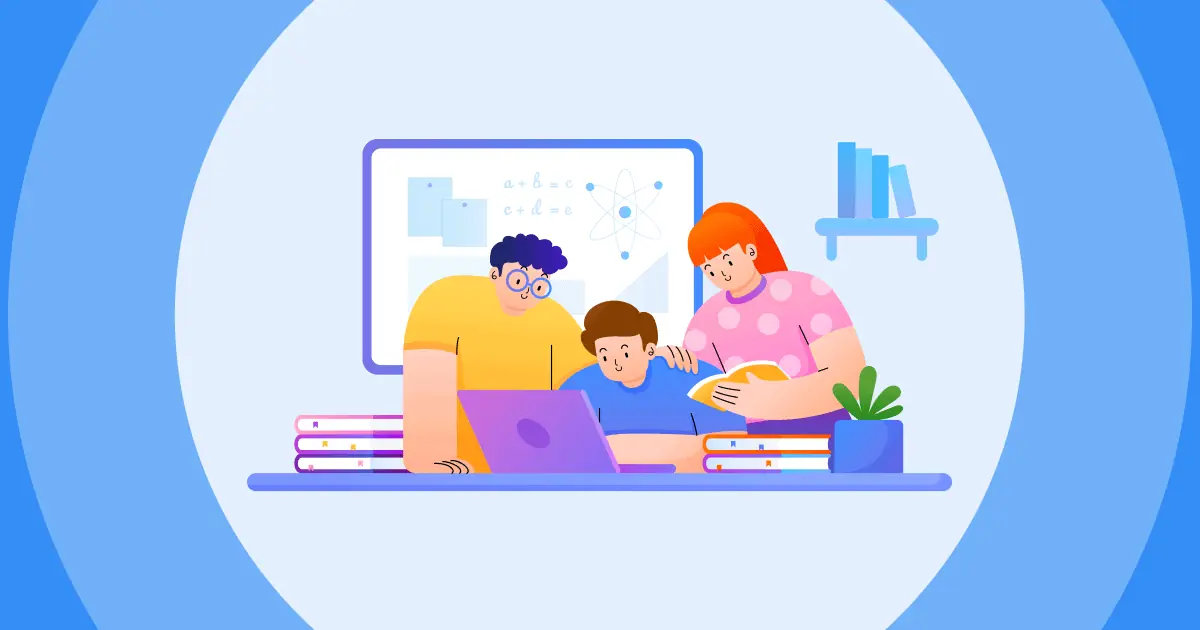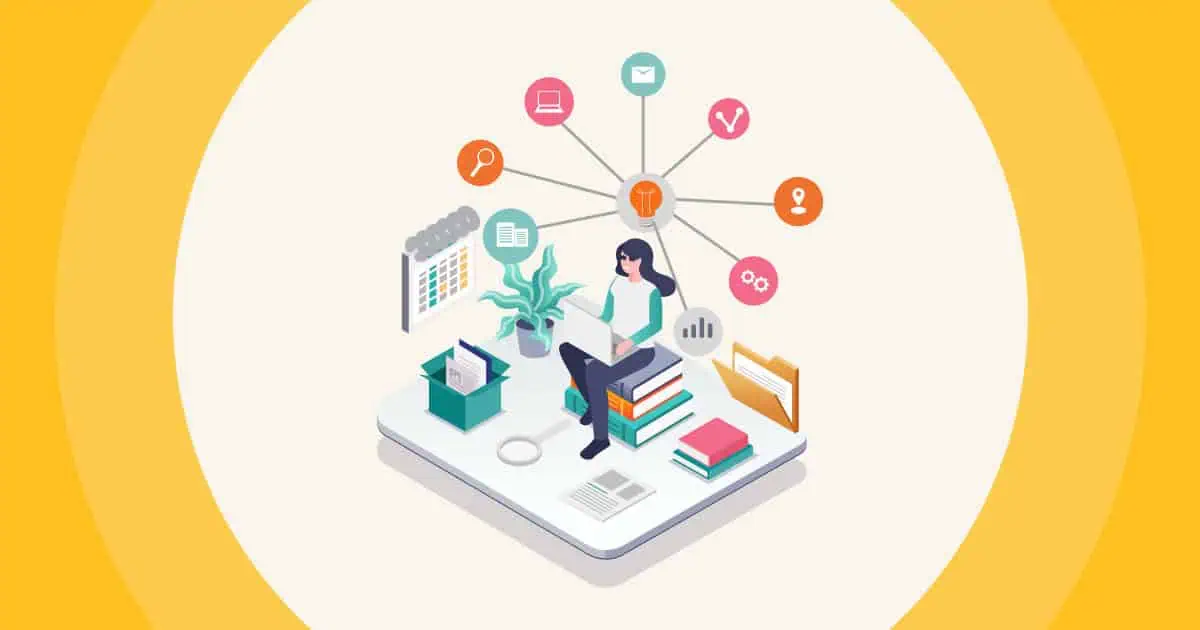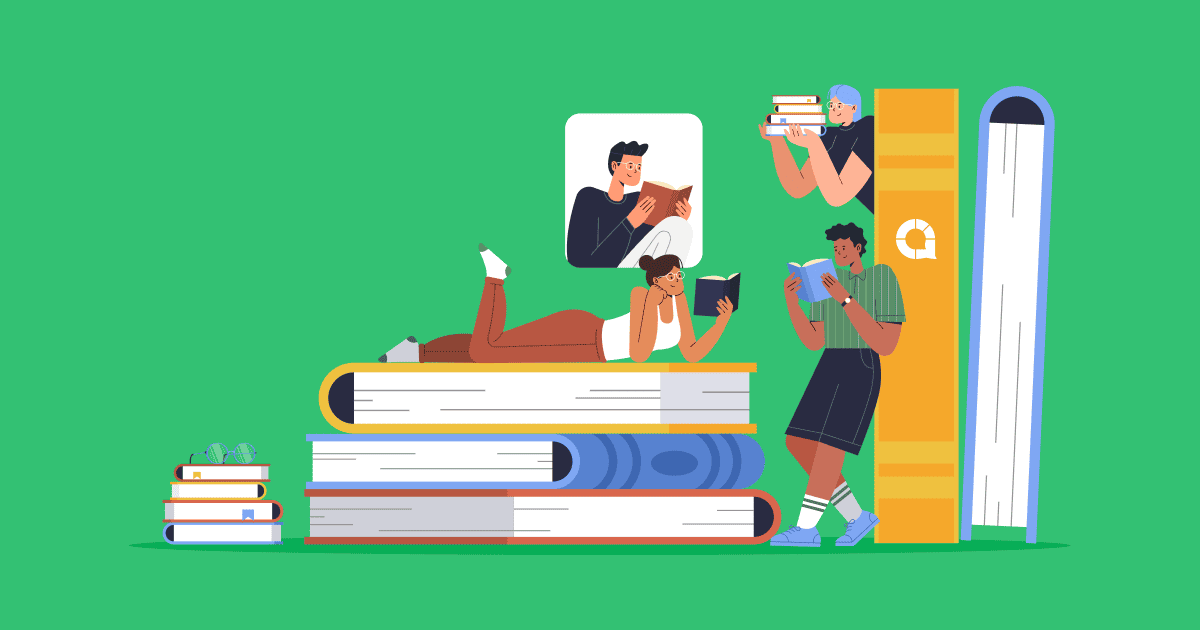Irakaskuntza-metodo berritzaileak ez dira hitz dotoreak soilik, baizik eta ikasleek benetan ikasgelan parte hartzen duten tresna ezinbestekoak dira. nahi ikasteko. Ohiko ikasgelan, online edo ingurune hibrido batean irakasten ari zaren ala ez, ikuspegi hauek irauli egin dezakete zure ikasleek edukiekin duten harremana eta etorkizunerako funtsezko trebetasunak garatzeko modua. Azter ditzagun teknika hauek eta zure ikasleekin errazteko aholkuak behean.
Edukien aurkibidea
- 15 Irakaskuntza-metodo berritzaileak
- 1. Ikasgai interaktiboak
- 2. Errealitate birtualeko teknologia erabiltzea
- 3. AI erabiltzea hezkuntzan
- 4. Ikaskuntza mistoa
- 5. 3D inprimaketa
- 6. Erabili diseinu-pentsamenduaren prozesua
- 7. Proiektuetan oinarritutako ikaskuntza
- 8. Kontsultan oinarritutako ikaskuntza
- 9.Puzlea
- 10. Galdera bidezko ikaskuntza
- 11. Ikasgela irauli
- 12. Irakaskuntza parekidea
- 13. Irakaskuntza moldagarria ikaskuntza-analisiekin
- 14. Irakaskuntza gurutzatua
- 15. Ikaskuntza pertsonalizatua
- Galdera arruntak
Zer dira Irakaskuntza Metodo Berritzaileak?
Irakaskuntza-metodo berritzaileak ez dira klasean punta-puntako teknologia erabiltzea edo hezkuntza-joerei etengabe heltzea.
Ikasleengan arreta gehiago jartzen duten estrategia didaktiko berriak erabiltzean aritzen dira. Berritzaile hauek ikasleak modu proaktiboan parte hartzera eta ikaskideekin eta zu -irakaslearekin- elkarrekin jartzera animatzen dituzte ikasgaietan. Ikasleek gehiago lan egin beharko dute, baina beren beharrak hobeto asetzeko eta azkarrago hazten lagun diezaiekeen moduan.
Irakaskuntza tradizionala ez bezala, zeina batez ere zure ikasleei transmiti diezaiokezun ezagutzan zentratzen dena, irakasteko modu berritzaileek sakontzen dute ikasleek hitzaldietan irakasten ari zarenetik benetan kentzen dutena.
Zergatik izan behar dute irakasleek berritzaileak
Online eta hibrido ikaskuntzarako aldaketak egia gogor bat agerian utzi du: oso erraza da ikasleentzat pantailen atzean despistatzea. Askok hobetu dute arreta erakartzeko artea, burua beste nonbait dabilen bitartean (edo okerrago, ohean dauden bitartean!).
Baina kontua hauxe da: ezin diegu erru guztia ikasleei bota. Irakasle gisa, arreta erakartzen eta parte-hartzea mantentzen duten ikasgaiak sortzeko ardura dugu. Irakaskuntza lehor eta monotonoa ez da nahikoa, irakaskuntza-metodoa edozein dela ere.
Zenbakiek istorio sinesgarria kontatzen dute. Datu berrienak hezkuntza-teknologiaren adopzioa ikuskizunak:
- AEBetako ikasleen % 57k badute beren ikaskuntza-gailu digitala
- AEBetako eskolen % 75ek gaitasun birtual osoak ezarri edo aurreikusi dituzte
- Hezkuntza-plataformek ikasleen gailuen erabileraren % 40 hartzen dute.
- Urruneko ikaskuntza kudeatzeko aplikazioen erabilera % 87 handitu da
- Lankidetza aplikazioen erabilera % 141 igo da
- Hezkuntza-erakundeen % 80k teknologia-tresna berrietan inbertitu dute
- Unibertsitateen % 98k online irakaskuntza eskaintzen zuten
Estatistika hauek irakasteko eta ikasteko dugun moduan funtsezko aldaketa bat agerian uzten dute. Ez geratu metodo zaharkituekin atzean: hezkuntzarako zure ikuspegia berriro imajinatzeko garaia da.
15 Irakaskuntza-metodo berritzaileak
1. Ikasgai interaktiboak
Ikasleak zure ikasle berritzaileak dira! Norabide bakarreko ikasgaiak oso tradizionalak dira eta batzuetan nekagarriak dira zuretzat eta zure ikasleentzat, beraz, sortu ingurune bat non ikasleak hitz egitera eta ideiak adieraztera animatuta sentituko diren.
Ikasleek modu askotan parte har dezakete klaseko jardueretan, ez bakarrik eskuak altxatuz edo erantzuteko deia jasoz. Egun, ikasgelako jarduera interaktiboak egiten lagunduko dizuten lineako plataformak aurki ditzakezu, denbora piloa aurrezteko eta ikasle guztiak bi edo hiru baino ez batzeko.
🌟 Ikasgai interaktiboen adibideak
Plataforma interaktibo modernoek irauli egin dute ikasgelako parte-hartzea. Eskua altxatzen duten hiru ikasle berberen menpe egon beharrean, zure klase osoa inplikatu dezakezu honen bidez: zuzeneko galdetegiak, inkestak, hitz-lainoak, galdera-erantzun saioak eta lankidetzako brainstorming jarduerak.
Ez hori bakarrik, ikasleek erantzunak modu anonimoan idatzi edo aukeratu ditzakete eskua altxatu beharrean. Horrek ziurtasun handiagoa ematen die parte hartzeko, beren iritziak adierazteko eta jada ez kezkatzeko "oker" edo epaitzeko.
Aholku praktikoa: Hasi hurrengo ikasgaia ikasleei gaiari buruz zer dakiten galdetuz inkesta anonimo batekin. Erabili emaitzak zure irakaskuntza berehala egokitzeko, ideia okerrak konponduz eta dagoeneko duzun ezagutzan oinarrituz.
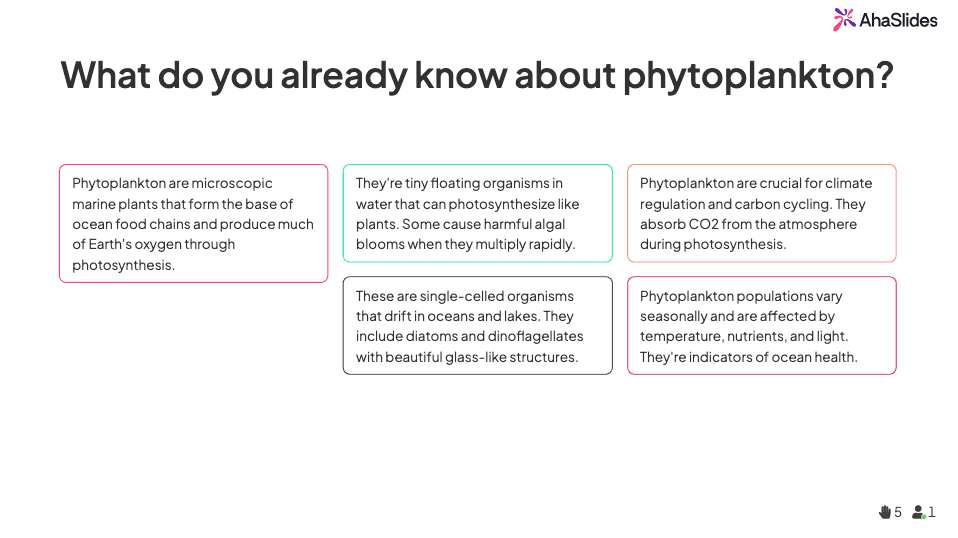
2. Errealitate birtualeko teknologia erabiltzea
Imajinatu zure ikasleak Marteren gainazala arakatzen, antzinako Erroman zehar ibiltzen edo zelulak barrutik behatzeko txikitzen. Hori da errealitate birtualeko boterea hezkuntzan: kontzeptu abstraktuak esperientzia ukigarri eta gogoangarri bihurtzen ditu.
VR teknologiak murgiltze-ikaskuntza inguruneak sortzen ditu, non ikasleek testuliburuetako irudi estatikoen ordez hiru dimentsioko irudikapenekin elkarreragiten duten. Objektuak manipulatu, espazioak arakatu eta benetako bizitzan ezinezkoak edo praktikoak ez liratekeen eszenatokiak bizi ditzakete.
Bai, errealitate birtualeko ekipamenduak inbertsio handia dira. Baina ikasleen parte-hartzean eta atxikipenean duen eraginak askotan kostua justifikatzen du. Ikasleek esperientziak askoz hobeto gogoratzen dituzte hitzaldiak baino, eta errealitate birtualeko ikaskuntza une ahaztezinak sortzen ditu.
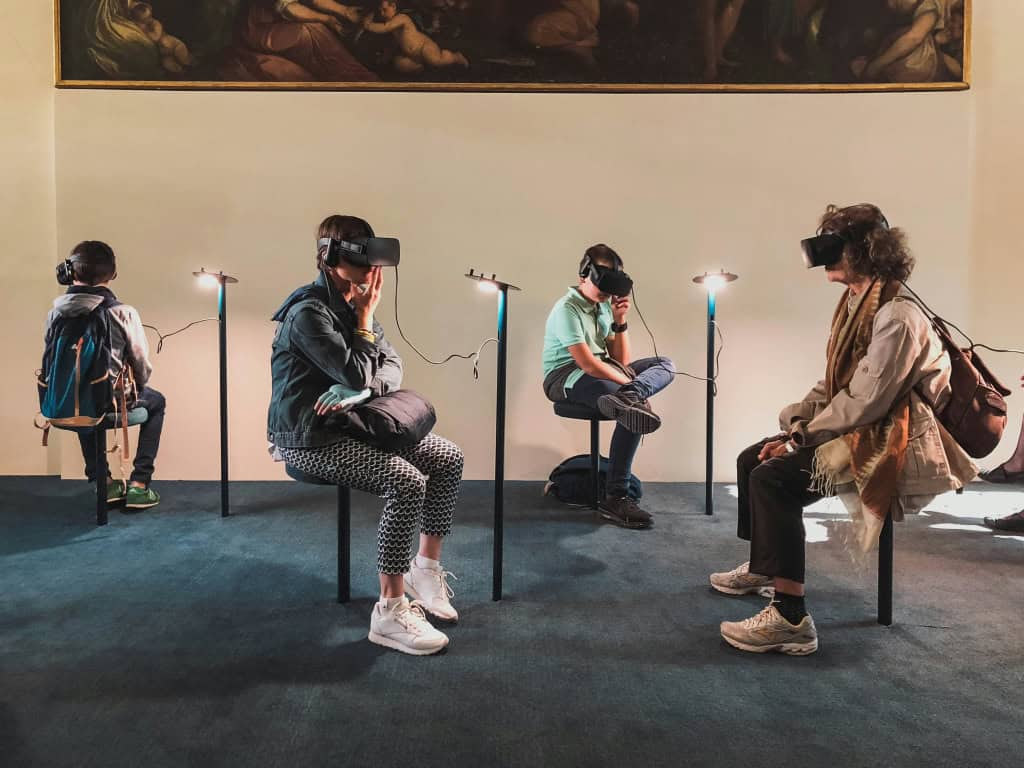
🌟 Irakaskuntza Errealitate Birtualeko Teknologiarekin
Dibertigarria dirudi, baina nola irakasten dute irakasleek benetako VR teknologiarekin? Ikusi Tablet Academy-ren VR saio baten bideo hau.
3. AI erabiltzea hezkuntzan
Hel dezagun gelako elefanteari: IA ez dago hemen irakasleak ordezkatzeko. Aitzitik, lan-karga murrizteko eta irakaskuntza pertsonalizatzeko tresna indartsua da, lehen posible ez ziren moduan.
Seguruenik, konturatu gabe erabiltzen ari zara dagoeneko adimen artifizialaren bidezko tresnak: ikaskuntza kudeatzeko sistemek, plagio-egiaztatzaileek, kalifikazio automatizatuek eta ikaskuntza-plataforma moldagarriek adimen artifiziala erabiltzen dute. Tresna hauek denbora asko eskatzen duten administrazio-zereginak kudeatzen dituzte, benetan garrantzitsua den horretan zentratu ahal izateko askatasuna emanez: ikasleekin konektatzea eta ikaskuntza sakona erraztea.
Adimen artifiziala hainbat aplikazio hezitzailetan nabarmentzen da:
- Ikastaroen kudeaketa – Materialak antolatzea, aurrerapena jarraitzea eta zereginak kudeatzea
- Ikaskuntza egokitzailea – Zailtasuna eta edukia ikasle bakoitzaren errendimenduaren arabera egokitzea
- komunikazioa – Gurasoen eta irakasleen arteko harremanak eta ikasleen laguntza erraztea
- Edukia sortzea – Ikaskuntza-material eta ebaluazio pertsonalizatuak sortzea
Kontuz hitza: Erabili IA irakaskuntza-laguntzaile gisa, ez gizakiaren epaiaren ordezko gisa. Berrikusi beti IAk sortutako edukia eta mantendu ikasleekin duzun lotura pertsonala, hori ezin baita errepikatu algoritmorik.
4. Ikaskuntza mistoa
Ikaskuntza mistoak bi munduetako onena konbinatzen du: aurrez aurreko irakaskuntza eta ikaskuntza digitaleko esperientziak. Ikuspegi honek malgutasuna eskaintzen die bai irakasleei bai ikasleei, hezkuntza esanguratsua egiten duen lotura pertsonala mantenduz.
Gure teknologiaz betetako munduan, tresna digital indartsuak alde batera uztea zentzugabea litzateke. Bideo-konferentziek, ikaskuntza kudeatzeko sistemek, plataforma interaktiboek eta hezkuntza-aplikazio ugarik frogatu dute beren balioa. Baina baita aurrez aurreko irakaskuntzak ere, bere eztabaidekin, berehalako feedbackarekin eta giza konexioarekin.
Ikaskuntza mistoak teknologia erabiltzeko aukera ematen dizu irakaskuntza tradizionala hobetzeko —ez ordezkatzeko—. Ikasleek etxean bideo didaktikoak ikus ditzakete, eta gero klaseko denbora erabil dezakete jarduera praktikoetarako, eztabaidetarako eta lankidetza-proiektuetarako. Edo tresna digitalak erabil ditzakezu aurrez aurreko eskoletan parte-hartzea handitzeko eta denbora errealeko iritzia jasotzeko.
Inplementazio ideia: Sortu "iraulitako" unitate bat, non ikasleek etxean (edo norberaren kabuz lan egiten duten bitartean) bideo-ikasgai laburrak ikusten dituzten, eta gero erabili klaseko saioak aplikazio-jardueretarako, arazoak konpontzeko eta ikaskideen arteko lankidetzarako. Horrek aurrez aurreko denbora baliotsua maximizatzen du.
5. 3D inprimaketa
3D inprimaketak kontzeptu abstraktuak ikasleen eskuetara ekartzen ditu, literalki. Irudi eta diagrama lauek parekatu ezin duten zerbait indartsua dago fisikoki eustea eta aztertzea eredu bat aztertzean.
Ikasleek eredu anatomikoak manipulatu ditzakete gorputz-sistemak ulertzeko, arkitektura-egiturak angelu guztietatik aztertzeko, artefaktu historikoak sortzeko, ingeniaritza-prototipoak diseinatzeko edo kontzeptu matematikoak bistaratzeko. Aukerak gai-arlo guztiak hartzen dituzte.
3D inprimatutako objektuak behatzeaz gain, diseinu-prozesuak berak trebetasun baliotsuak irakasten ditu. Ikasleek beren ereduak sortzen dituztenean, arrazoiketa espaziala, arazoak konpontzeko gaitasunak eta diseinu-pentsamendu iteratiboa garatzen dituzte.
Aurrekontuarekiko errespetuzko ikuspegia: Zure eskolak 3D inprimagailurik ez badu, tokiko liburutegi, makerspace eta unibertsitate-instalazio askok sarbide publikoa eskaintzen dute. Lineako zerbitzuek diseinuak inprimatu eta bidal ditzakete modu merkean. Hasi doako hezkuntza-ereduak deskargatzen zure ekipamenduan inbertitu aurretik.
6. Erabili diseinu-pentsamenduaren prozesua
Hau irtenbideetan oinarritutako estrategia bat da, arazoak konpontzeko, elkarlanean aritzeko eta ikasleen sormena pizteko. Bost etapa daude, baina beste metodoetatik desberdina da, ez duzulako urratsez urrats gida bat edo inolako agindurik jarraitu beharrik. Prozesu ez-lineala da, beraz, zure hitzaldi eta jardueren arabera pertsonaliza dezakezu.
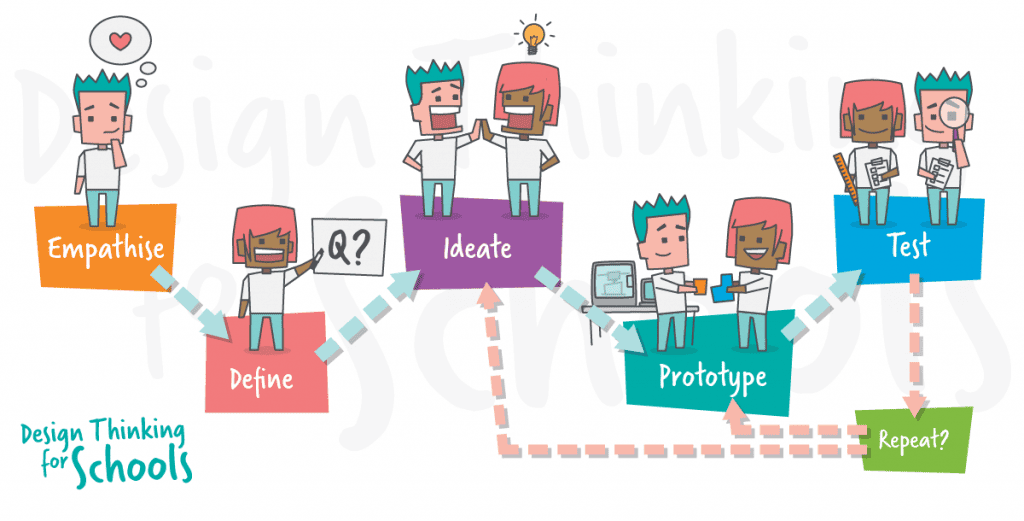
Bost etapa hauek dira:
- Enpatizatu - Enpatia garatu, eta irtenbideen beharrak ezagutu.
- Definitu - Arazoak eta horiei aurre egiteko ahalmena definitzea.
- Ideia - Ideia berriak eta sortzaileak pentsatu eta sortu.
- Prototype - Egin irtenbideen zirriborroa edo lagin bat ideiak gehiago aztertzeko.
- Test - Konponbideak probatu, ebaluatu eta iritziak bildu.
🌟 Diseinu-pentsamenduaren prozesuaren adibidea
Benetako klase batean nola doan ikusi nahi duzu? Hona hemen Design 8 Campuseko K-39ko ikasleek nola lan egiten duten esparru honekin.
7. Proiektuetan oinarritutako ikaskuntza
Proiektuetan oinarritutako ikaskuntzak (PBL) hezkuntza tradizionala hankaz gora jartzen du. Edukiak lehenik ikasi eta gero aplikatu beharrean, ikasleek benetako munduko arazoei aurre egiten diete, eta bidean eduki eta trebetasun berriak ikasi behar dituzte.
Unitate amaierako proiektu estandarrekiko desberdintasun nagusia: PBL proiektuak ikaskuntza esperientzia dira, ez amaieran gehitzen den ebaluazio bat soilik. Ikasleak denbora luzez lan egiten dute, ikerketa trebetasunak, pentsamendu kritikoa, lankidetza gaitasunak eta gaiaren espezializazioa aldi berean garatuz.
Zure rola informazioa banatzen duen pertsonatik errazten eta gidatzen duen pertsonara aldatzen da. Ikasleek beren ikaskuntza-bidaiaren ardura hartzen dute, eta horrek nabarmen handitzen du parte-hartzea eta atxikipena. Ez dituzte datuak buruz ikasten bakarrik, baizik eta ezagutza aplikatzen ari dira zerbait esanguratsua sortzeko.
sinesgarria proiektuaren ideiak honako hauek dira:
- Tokiko gizarte arazo bati buruzko dokumental bat filmatzea
- Eskolako ekitaldi edo diru-bilketa bat planifikatu eta gauzatzea
- Komunitate-erakunde baten sare sozialetako kanpaina bat kudeatzea
- Gizarte-arazoen analisi bisualak sortzea proposatutako irtenbideekin
- Tokiko enpresentzako iraunkortasun planak garatzea
Arrakastarako aholkua: Ziurtatu proiektuek zuregandik haratagoko benetako publikoa dutela. Ikasleek komunitateko kideei, tokiko profesionalei edo ikasle gazteagoei aurkezten dietenean, jokoan dagoena erreala da eta motibazioa izugarri handitzen da.
8. Kontsultan oinarritutako ikaskuntza
Galdera bidezko ikaskuntza galderekin hasten da, ez erantzunekin. Hitzaldi bat eman eta gero ulermena ebaluatu beharrean, ikasleek modu independentean edo elkarlanean ikertu behar dituzten arazoak edo egoerak planteatzen dituzu.
Metodo honek irakasle baten ordez, erraztaile gisa kokatzen zaitu. Ikasleek ikerketa trebetasunak, pentsamendu kritikoa eta autoikaskuntza gaitasunak garatzen dituzte galdera interesgarriei erantzunak bilatzen dituzten heinean.
Prozesuak normalean ikasleak inplikatzen ditu:
- Arazo edo galdera bati aurre egitea
- Hipotesiak edo iragarpenak formulatzea
- Ikerketak edo ikerketa-ikuspegiak diseinatzea
- Informazioa biltzea eta aztertzea
- Ondorioak ateratzea eta aurkikuntzei buruz hausnartzea
- Emaitzak besteei komunikatzea
Kontsultan oinarritutako eszenatokiek honako hauek izan ditzakete:
- Zure komunitateko kutsadura iturriak ikertzea eta irtenbideak proposatzea
- Landareen hazkuntzarekin esperimentuak hainbat baldintzatan
- Eskola-politiken eraginkortasuna ebaluatzea
- Ikasleek eurek sortzen dituzten galderak ikertzea, intereseko gaiei buruz
Aldamioetarako aholkua: Hasi galdera eta metodoa zuk ematen dituzun ikerketa egituratuarekin, eta gero, pixkanaka, erantzukizuna askatu ikasleek beren galderak sortu eta ikerketak modu independentean diseinatu arte.
9.Puzlea
Puzzle bat muntatzearen antzera, lankidetzako ikaskuntza estrategia honek ikasleek beren ezagutza kolektiboa elkartzea eskatzen du gaiaren irudi osoa osatzeko.
Hona hemen nola funtzionatzen duen:
- Banatu zure klasea talde txikitan
- Esleitu talde bakoitzari azpigai edo gai nagusiaren alderdi desberdin bat
- Taldeek ikertu eta esleitutako lana "aditu" bihurtzea
- Talde bakoitzak bere aurkikuntzak klaseari aurkezten dizkio
- Elkarrekin, aurkezpenek gai osoaren ulermen osoa osatzen dute
- Aukeran, taldeek elkarren lana ebaluatzen duten parekideen arteko feedback saioak antolatu.
Esperientzia handiagoa duten klaseentzat, azpigai desberdinak eslei diezazkiekezu ikasle bakoitzari. Lehenik eta behin, azpigai bera ikasten ari diren ikaskideekin elkartzen dira (adituen taldeak), eta gero jatorrizko taldera itzultzen dira ikasitakoa irakasteko.
Gai espezifikoen adibideak:
- Hizkuntzaren arteak: Esleitu taldeei eleberri bereko elementu literario desberdinak (pertsonaia, giroa, gaiak, sinbolismoa)
- Historia: Taldeek gertaera historiko baten alderdi desberdinak ikertzea (kausak, pertsonaia nagusiak, gudu nagusiak, ondorioak, ondarea)
- Zientzia: Ikasleek gorputz-sistema desberdinak ikertzen dituzte, eta gero ikaskideei nola elkarri lotzen zaizkien irakasten diete
Zergatik funtzionatzen du: Edukia ikaskideei irakasteak ulermen sakonagoa eskatzen du, ikastea baino. Ikasleek beren lana benetan ulertu behar dute argi azaltzeko, eta ikaskideen aurrean dira erantzuleak, ez zuri bakarrik.
10. Galdera bidezko ikaskuntza
Galdera bidezko ikaskuntzak jakin-mina jartzen du hezkuntzaren erdigunean. Irakasleek erantzun guztiak eman beharrean, ikasleek beren ikaskuntza bultzatzen dute galderak eginez, gaiak ikertuz eta ezagutza eraikiz esplorazioaren eta aurkikuntzaren bidez.
Ikuspegi honek ikasleak hartzaile pasiboetatik ikertzaile aktibo bihurtzen ditu. Irakasleak informazioaren atezain izan beharrean, ikerketa prozesua gidatzen duten erraztaile gisa jokatzen dute. Ikasleek pentsamendu kritikoa, ikerketa trebetasunak eta ulermen sakonagoa garatzen dituzte, haientzat garrantzitsuak diren galderei erantzunak aurkitzen pertsonalki inplikatuta baitaude.
Ikerketa zikloa normalean fasez fase mugitzen da: ikasleek galderak egiten dituzte, ikerketak planifikatzen dituzte, informazioa biltzen eta aztertzen dute, ondorioak ateratzen dituzte eta ikasitakoaren gainean hausnartzen dute. Honek islatzen du benetako zientzialariek, historialariek eta profesionalek nola lan egiten duten arloan.
Galdera bidezko ikaskuntza bereziki indartsua egiten duena da ikasleei irakasten diela nola ikasteko, ez bakarrik zer ikasteko. Arazoak konpontzeko gaitasunak eta erresilientzia garatzen dituzte erronkei aurre egitean, eta horrek bizitza osorako ikaskuntzarako prestatzen ditu.
🌟 Galdera bidezko ikaskuntzaren adibideak
- Zientzia ikerketaIkasleei landareak nola hazten diren esan beharrean, galdetu "Zer behar dute landareek bizirauteko?". Utzi ikasleei argia, ura eta lurzoruaren kalitatea bezalako aldagai desberdinak probatzen dituzten esperimentuak diseinatzen.
- Ikerketa historikoaGertaera historiko bati buruzko hitzaldia eman beharrean, galdera hau egin: "Zergatik erori zen Berlingo Harresia?". Ikasleek hainbat ikuspegi, iturri nagusi eta testuinguru historiko ikertzen dituzte beren ulermena eraikitzeko.
- Matematika esploratzeaBenetako arazo bat aurkeztu: "Nola birdiseinatu dezakegu gure eskolako jolastokia aurrekontuaren barruan jolas-eremuak maximizatzeko?" Ikasleek kontzeptu matematikoak aplikatzen dituzte irtenbide praktikoak ikertzen dituzten bitartean.
11. Ikasgela irauli
The iraulitako ikasgela eredua irakaskuntza tradizionala alderantzikatzen du: edukia etxean ematen da, eta aplikazioa eta praktika, berriz, gelan.
Klasea baino lehen, ikasleek bideoak ikusten dituzte, materialak irakurtzen dituzte edo baliabideak aztertzen dituzte oinarrizko ezagutzak lortzeko. Ondoren, klaseko denbora baliotsua tradizionalki "etxeko lan"tzat hartzen diren jarduerei eskaintzen zaie: kontzeptuak aplikatzea, arazoak konpontzea, ideiak eztabaidatzea eta proiektuetan elkarlanean aritzea.
Ikuspegi honek hainbat abantaila eskaintzen ditu. Ikasleek behar duten moduan pausatu, atzeratu eta berriro ikusi dezakete irakaskuntza-edukia, beren erritmoan ikasiz. Zailtasunak dituzten ikasleek denbora gehiago dute oinarrizko materialarekin, eta aurreratuagoek, berriz, oinarrizko gaiak azkar aztertu eta luzapenetan sakondu.
Bitartean, klasean zehar eskuragarri zaude ikasleek benetan gehien behar zaituzten uneetarako; hau da, aplikazio zailekin borrokan ari direnean, azalpenei pasiboki entzuten ez dituztenean.
Inplementazio estrategia: Sortu bideo-ikasgai labur eta zehatzak (gehienez 5-10 minutu). Ikasleek arreta-tarte laburra dute grabatutako edukiarekin, beraz, mantendu laburra eta erakargarria. Erabili klaseko denbora jarduera praktikoetarako, eztabaidetarako eta zure espezializazioak benetako balioa gehitzen duen arazoen ebazpen kolaboratiboetarako.
Ikasgela irauli bat nola dagoen eta nola gertatzen den jakin nahi duzu bizitza errealeanIkusi McGraw-Hill-ek egindako bideo hau haien klase alderantzikatuaren inguruan.
12. Irakaskuntza parekidea
Jigsaw teknikan aztertu dugunaren antzekoa da hau. Ikasleek ezagutzak hobeto ulertzen eta menperatzen dituzte argi eta garbi azaltzen dituztenean. Aurkeztean, baliteke aldez aurretik bihotzez ikasi eta gogoratzen dutena ozen hitz egitea, baina beren kideei irakasteko, arazoa ondo ulertu behar dute.
Ikasleek jarduera honen protagonismoa har dezakete irakasgaiaren barruko interes-eremua aukeratuz. Ikasleei autonomia mota hori emateak irakasgaiaren jabego sentimendua eta ongi irakasteko erantzukizuna garatzen laguntzen die.
Gainera, ikusiko duzu ikasleei ikaskideei irakasteko aukera emateak konfiantza areagotzen duela, ikasketa independentea sustatzen duela eta aurkezpen gaitasunak hobetzen dituela.
🌟 Ikaskideen Irakaskuntza Adibideak
Ikusi Dulwich High School of Visual Arts and Design-eko ikasle gazte batek emandako matematikako ikasgai natural eta dinamiko baten bideo hau!
13. Irakaskuntza moldagarria ikaskuntza-analisiekin
Irakaskuntza moldagarriak datuak eta teknologia erabiltzen ditu ikasle bakoitzarentzako denbora errealeko irakaskuntza pertsonalizatzeko. Ikaskuntza-analisi tresnek ikasleen errendimenduari, parte-hartzeari eta ikaskuntza-ereduei buruzko informazioa biltzen dute, eta gero irakasleei irakaskuntza-estrategiak egokitzen laguntzen diete banakako beharretara egokitzeko.
Metodo honek neurri bakarreko irakaskuntza tradizionala gainditzen du, ikasle bakoitzak modu ezberdinean eta bere erritmoan ikasten duela aitortuz. Irakasleek aginte-panelak eta txostenak erabil ditzakete zein ikaslek behar duten laguntza gehigarria, zein dauden prest material erronka handiagoetarako eta zein kontzepturekin arazoak dituen klase osoak identifikatzeko.
Ikaskuntza-analisi plataformek galdetegien puntuazioetatik eta zereginen burutzapenetik hasi eta zereginetan emandako denbora eta interakzio-ereduetaraino dena kontrolatzen dute. Datu hauek irakasleei ikuspegi erabilgarriak ematen dizkiete, intuizioetan edo aldizkako probetan soilik oinarritu gabe.
🌟 Irakaskuntza moldagarria ikaskuntza-analisi adibideekin
Ikaskuntza kudeatzeko sistemaren (LMS) datuakGoogle Classroom bezalako plataformak, Canvas, edo Moodle-k ikasleen parte-hartzearen neurriak jarraitzen ditu: ikasleek noiz atzitzen dituzten materialak, zenbat denbora ematen duten irakurtzen, zein baliabide berrikusi. Irakasleek deskonpromiso-ereduak erakusten dituzten ikasleengana jo dezakete atzean geratu aurretik.
Egokitutako ikaskuntza plataformakErabili Khan Academy edo IXL bezalako tresnak, ikasleen erantzunen arabera galderen zailtasuna automatikoki doitzen dutenak. Irakasleek txosten zehatzak jasotzen dituzte, ikasle bakoitzak zein kontzeptu menperatu dituen eta non dauden arazoak erakusten dituztenak.
Denbora errealeko ebaluazio formatiboa: Klaseetan zehar, Erabili AhaSlides edo Kahoot bezalako plataformak ulermena azkar egiaztatzeko.Analitikek berehala erakusten dute zein ikasleek erantzun dituzten galderak zuzen edo oker, kontzeptuak bertan berriro irakasteko edo talde txikiak osatzeko aukera emanez.
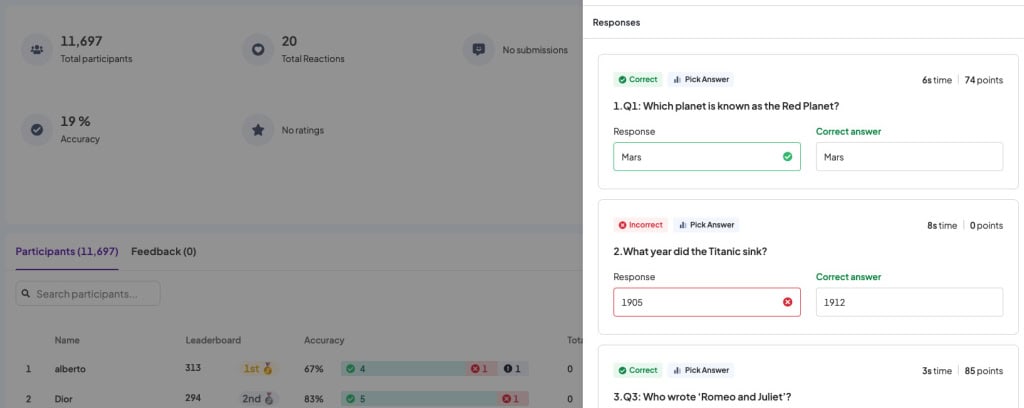
14. Irakaskuntza gurutzatua
Gogoratzen al duzu nolako ilusioa egin zenuen zure klasea museora, erakusketara edo bidai batera joan zenean? Beti pozgarria da kalera atera eta ikasgelan arbelari begiratzea baino zerbait desberdina egitea.
Crossover teaching-ek ikasgelan zein kanpoko leku batean ikastearen esperientzia uztartzen du. Arakatu elkarrekin eskolan kontzeptuak, eta antolatu bisita bat leku jakin batera, non kontzeptu horrek ingurune errealean nola funtzionatzen duen erakusteko.
Are eraginkorragoa izango litzateke ikasgaia gehiago garatzea, bidaiaren ostean eztabaidak antolatuz edo talde-lana klasean esleituz.
🌟 Gurutze birtualeko irakaskuntzaren adibidea
Batzuetan, kalera ateratzea ez da beti posible, baina badira bideak. Begiratu Arte Modernoaren Museoaren bisita birtuala Southfield School Art-eko Gauthier andrearekin.
15. Ikaskuntza pertsonalizatua
Hona hemen egia deseroso bat: ikasle batzuentzat bikain funtzionatzen duena beste batzuentzat erabat porrot egiten du. Taldeko jarduerek estrabertituak pizten dituzte, baina introbertituak gainditzen dituzte. Ikasle bisualek diagramekin hobetzen dute, eta ahozko ikasleek eztabaida nahiago dute. Erritmo bizkorreko ikasgaiek batzuk erakartzen dituzte, beste batzuk atzean uzten dituzten bitartean.
Ikaskuntza pertsonalizatuak desberdintasun horiek aitortzen ditu eta irakaskuntza ikasle bakoitzaren interes, behar, indargune eta ahulguneetara egokitzen du. Bai, aldez aurretik plangintza-denbora gehiago behar du. Baina ikasleen lorpenetan eta parte-hartzean emaitza nabarmenak lortzen dira.
Pertsonalizazioak ez du esan nahi ikasle bakoitzarentzat ikasgai guztiz desberdinak sortzea. Aitzitik, aukerak, erritmo malgua, ebaluazio-metodo anitzak eta laguntza bereizia eskaintzea esan nahi du.
Tresna digitalek pertsonalizazioa inoiz baino errazagoa egiten dute. Ikaskuntza-plataforma moldagarriek zailtasuna automatikoki doitzen dute, ikaskuntza-kudeaketa sistemek banakako aurrerapena jarraitzen dute eta hainbat aplikaziok ikasleei ulermena modu askotan erakusteko aukera ematen diete.
Hasi txiki: Hasi aukera-taulekin, non ikasleek hainbat aukera hautatzen dituzten zeregin edo proiektuetarako. Edo erabili ebaluazio formatiboko datuak taldekatze malguak sortzeko; batzuetan zailtasunak dituzten ikasleekin lan egin, beste batzuek luzapenak egiten dituzten bitartean, beste batzuetan gaitasunaren arabera baino interesen arabera taldekatuz. Pixkanaka pertsonalizazio gehiago txertatu erosoago zauden heinean.
Galdera arruntak
Nola aukeratu dezaket zein metodo berritzaile probatu lehenengo?
Hasi zure irakaskuntza-estiloarekin eta eskuragarri dauden baliabideekin bat datorrenarekin. Teknologiarekin eroso bazaude, probatu lehenik ikasgai interaktiboak edo alderantzizko ikasgela. Ikaskuntza praktikoa nahiago baduzu, esperimentatu proiektuetan oinarritutako ikaskuntzarekin edo puzzle teknikarekin. Ez sentitu beharrik dena aldi berean hartzeko: metodo berri bakar batek ere eragin handia izan dezake ikasleen konpromisoan.
Zer gertatzen da nire ikasleek metodo berri hauei aurre egiten badiete?
Aldaketa deserosoa izan daiteke, batez ere ikaskuntza pasiboan ohituta dauden ikasleentzat. Hasi pixkanaka, azaldu zergatik probatzen ari zaren ikuspegi berriak eta izan pazientzia ikasleak egokitzen diren bitartean. Hasieran, ikasle askok nahiago dituzte metodo tradizionalak, ezagunak direlako besterik gabe, ez eraginkorragoak direlako. Ikasleek ikuspegi berritzaileekin arrakasta lortzen dutenean, erresistentzia normalean desagertzen da.
Ez al dute metodo hauek klaseko denbora gehiegi kentzen?
Hasieran, bai, metodo berriak ezartzeak egokitzapen denbora eskatzen du. Baina gogoratu, irakaskuntza ez dela edukia lantzea; ikasleek edukia ikastea baizik. Metodo berritzaileek askotan ulermen sakonagoa eta iraunkorragoa ematen dute ohiko hitzaldiekin alderatuta, material gutxiago lantzen baduzu ere. Kalitatea kantitatea baino handiagoa da. Gainera, zuk eta ikasleek ikuspegi hauekin ohitzen zareten heinean, eraginkorragoak bihurtzen dira.
